Detailed Analysis of Sainsbury's Global Business Environment Report
VerifiedAdded on 2023/01/05
|9
|2171
|36
Report
AI Summary
This report provides a comprehensive evaluation of Sainsbury's global business environment, examining the political, economic, and social factors that influence its performance. It delves into the importance of business objectives and geographical expansion for increased profitability and customer acquisition. The report analyzes various business environment theories, including mercantilism, absolute advantage, comparative advantage, Heckscher-Ohlin theory, product life cycle theory, and global strategic rivalry theory, to assess market conditions and competitive strategies. It also highlights the global business environment requirements, emphasizing the need for organizations to adhere to international rules and conduct thorough market environment evaluations. The report concludes that organizations like Sainsbury's must continuously adapt to the changing global landscape to maintain customer loyalty and achieve efficient goal attainment.
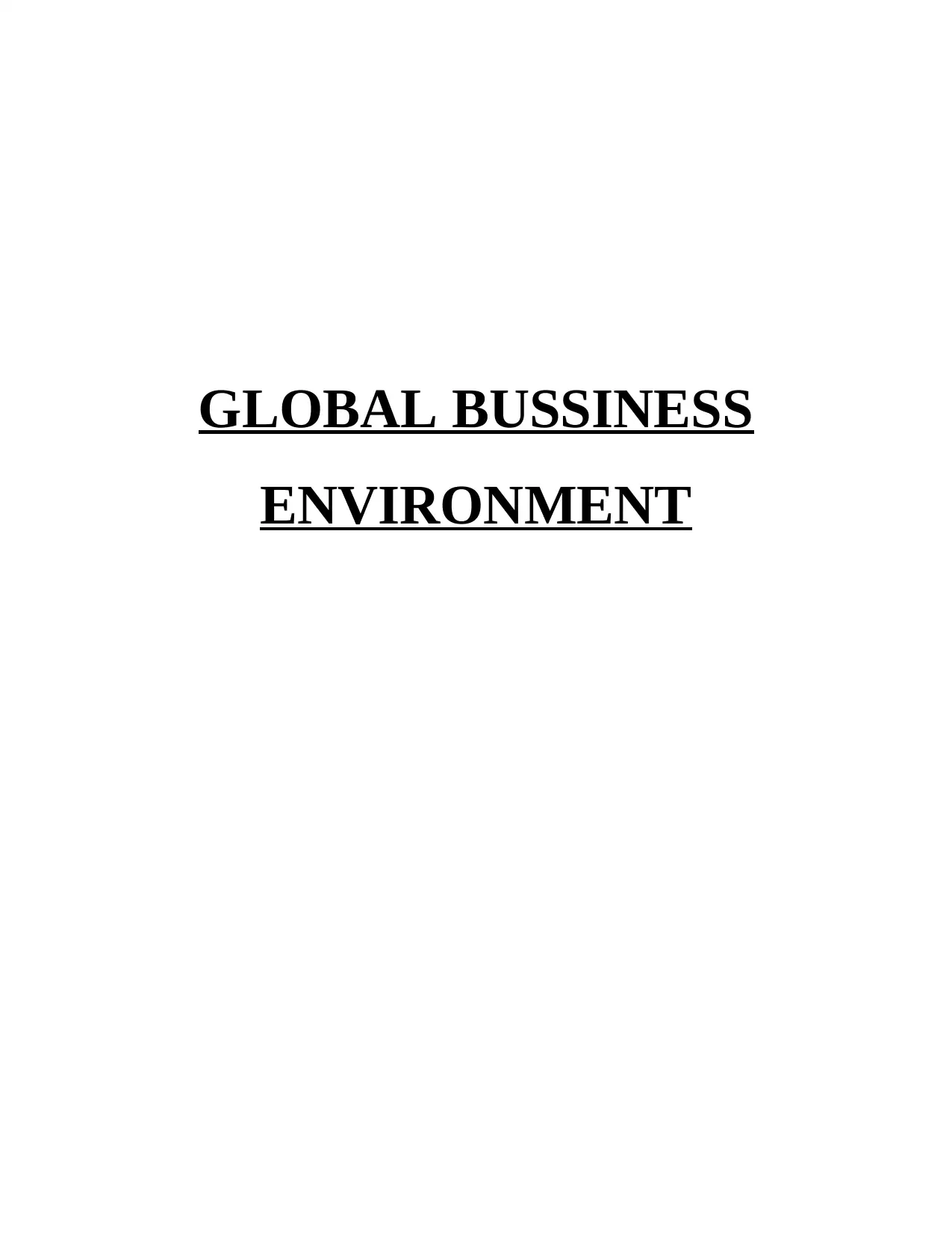
GLOBAL BUSSINESS
ENVIRONMENT
ENVIRONMENT
Paraphrase This Document
Need a fresh take? Get an instant paraphrase of this document with our AI Paraphraser
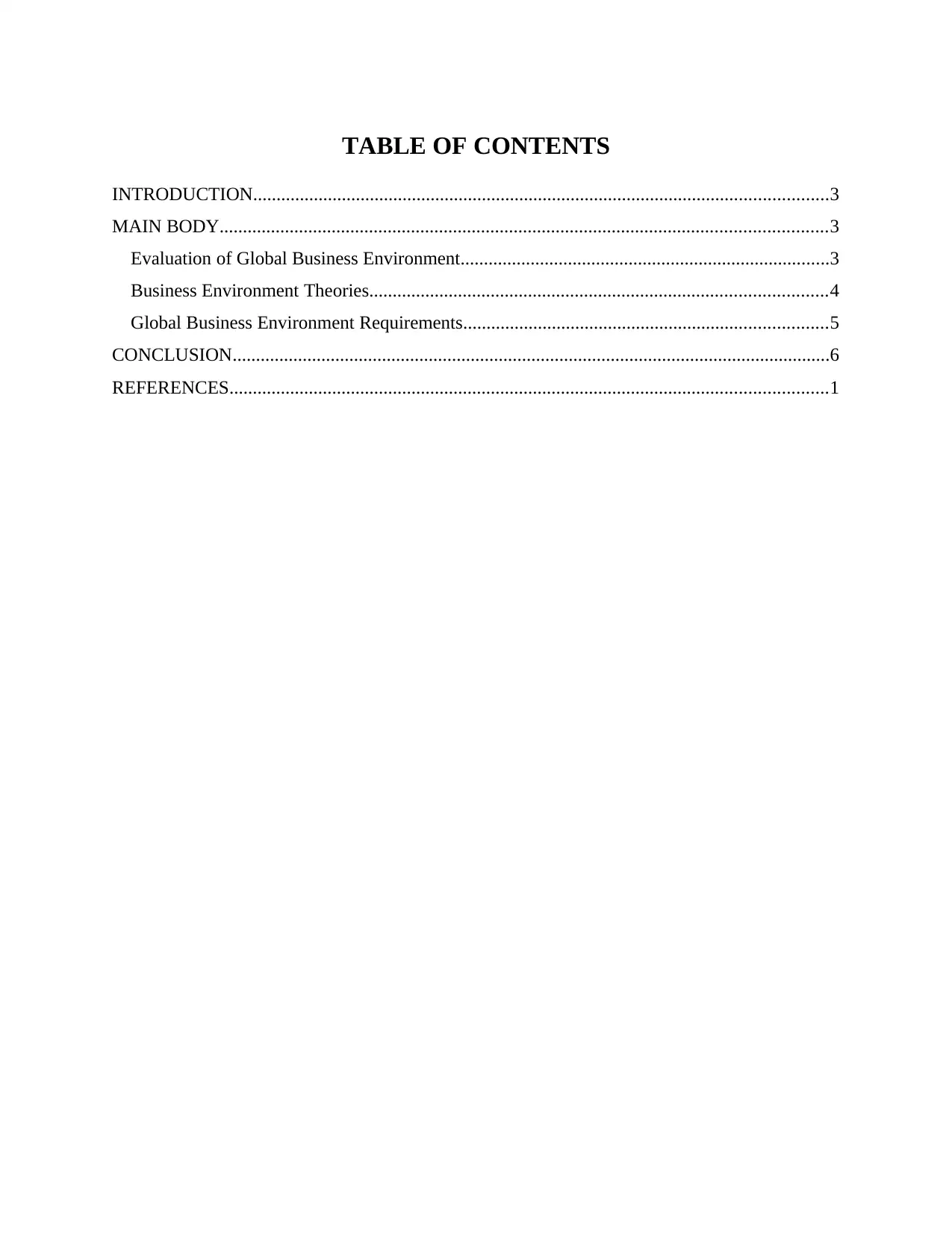
TABLE OF CONTENTS
INTRODUCTION...........................................................................................................................3
MAIN BODY..................................................................................................................................3
Evaluation of Global Business Environment...............................................................................3
Business Environment Theories..................................................................................................4
Global Business Environment Requirements..............................................................................5
CONCLUSION................................................................................................................................6
REFERENCES................................................................................................................................1
INTRODUCTION...........................................................................................................................3
MAIN BODY..................................................................................................................................3
Evaluation of Global Business Environment...............................................................................3
Business Environment Theories..................................................................................................4
Global Business Environment Requirements..............................................................................5
CONCLUSION................................................................................................................................6
REFERENCES................................................................................................................................1
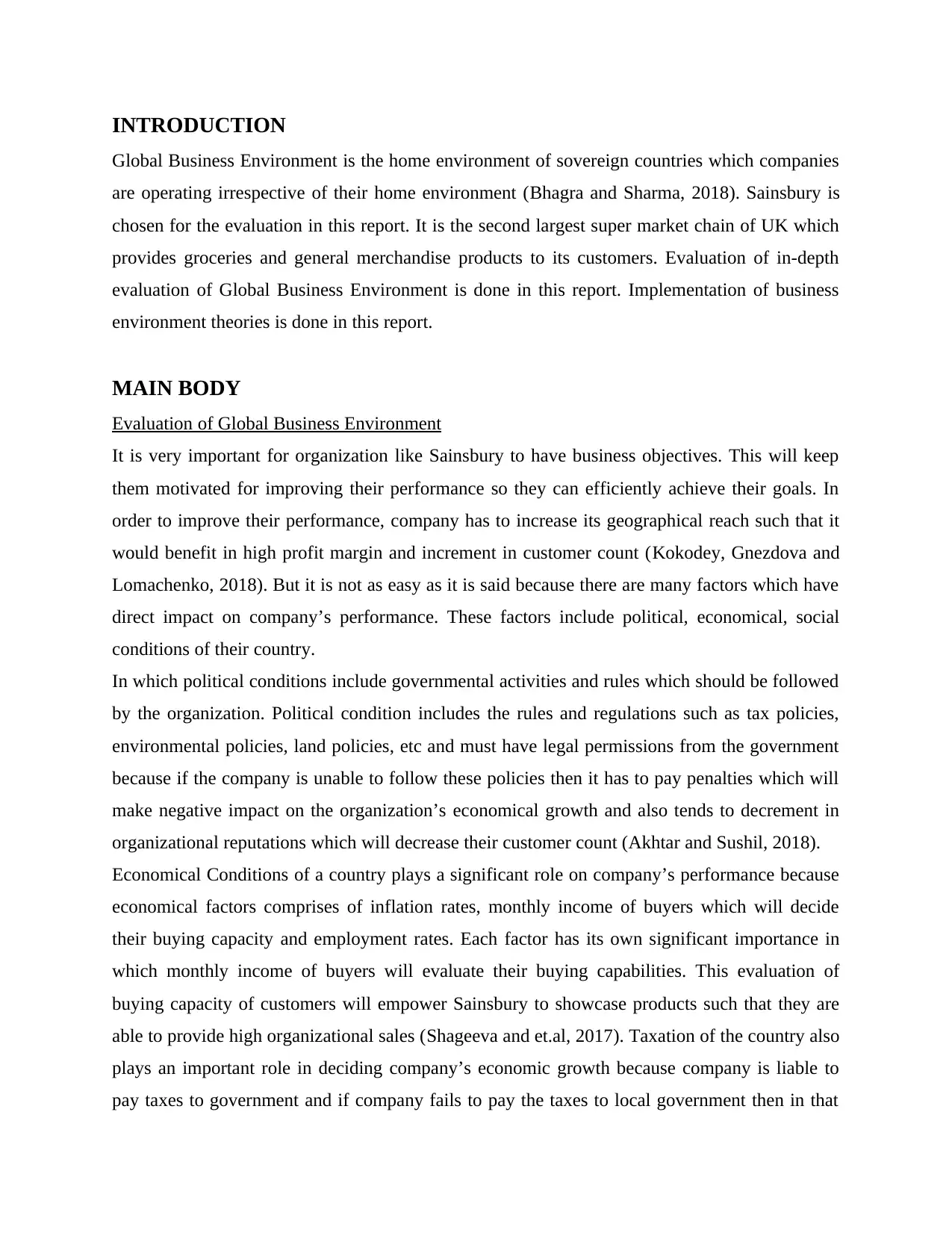
INTRODUCTION
Global Business Environment is the home environment of sovereign countries which companies
are operating irrespective of their home environment (Bhagra and Sharma, 2018). Sainsbury is
chosen for the evaluation in this report. It is the second largest super market chain of UK which
provides groceries and general merchandise products to its customers. Evaluation of in-depth
evaluation of Global Business Environment is done in this report. Implementation of business
environment theories is done in this report.
MAIN BODY
Evaluation of Global Business Environment
It is very important for organization like Sainsbury to have business objectives. This will keep
them motivated for improving their performance so they can efficiently achieve their goals. In
order to improve their performance, company has to increase its geographical reach such that it
would benefit in high profit margin and increment in customer count (Kokodey, Gnezdova and
Lomachenko, 2018). But it is not as easy as it is said because there are many factors which have
direct impact on company’s performance. These factors include political, economical, social
conditions of their country.
In which political conditions include governmental activities and rules which should be followed
by the organization. Political condition includes the rules and regulations such as tax policies,
environmental policies, land policies, etc and must have legal permissions from the government
because if the company is unable to follow these policies then it has to pay penalties which will
make negative impact on the organization’s economical growth and also tends to decrement in
organizational reputations which will decrease their customer count (Akhtar and Sushil, 2018).
Economical Conditions of a country plays a significant role on company’s performance because
economical factors comprises of inflation rates, monthly income of buyers which will decide
their buying capacity and employment rates. Each factor has its own significant importance in
which monthly income of buyers will evaluate their buying capabilities. This evaluation of
buying capacity of customers will empower Sainsbury to showcase products such that they are
able to provide high organizational sales (Shageeva and et.al, 2017). Taxation of the country also
plays an important role in deciding company’s economic growth because company is liable to
pay taxes to government and if company fails to pay the taxes to local government then in that
Global Business Environment is the home environment of sovereign countries which companies
are operating irrespective of their home environment (Bhagra and Sharma, 2018). Sainsbury is
chosen for the evaluation in this report. It is the second largest super market chain of UK which
provides groceries and general merchandise products to its customers. Evaluation of in-depth
evaluation of Global Business Environment is done in this report. Implementation of business
environment theories is done in this report.
MAIN BODY
Evaluation of Global Business Environment
It is very important for organization like Sainsbury to have business objectives. This will keep
them motivated for improving their performance so they can efficiently achieve their goals. In
order to improve their performance, company has to increase its geographical reach such that it
would benefit in high profit margin and increment in customer count (Kokodey, Gnezdova and
Lomachenko, 2018). But it is not as easy as it is said because there are many factors which have
direct impact on company’s performance. These factors include political, economical, social
conditions of their country.
In which political conditions include governmental activities and rules which should be followed
by the organization. Political condition includes the rules and regulations such as tax policies,
environmental policies, land policies, etc and must have legal permissions from the government
because if the company is unable to follow these policies then it has to pay penalties which will
make negative impact on the organization’s economical growth and also tends to decrement in
organizational reputations which will decrease their customer count (Akhtar and Sushil, 2018).
Economical Conditions of a country plays a significant role on company’s performance because
economical factors comprises of inflation rates, monthly income of buyers which will decide
their buying capacity and employment rates. Each factor has its own significant importance in
which monthly income of buyers will evaluate their buying capabilities. This evaluation of
buying capacity of customers will empower Sainsbury to showcase products such that they are
able to provide high organizational sales (Shageeva and et.al, 2017). Taxation of the country also
plays an important role in deciding company’s economic growth because company is liable to
pay taxes to government and if company fails to pay the taxes to local government then in that
⊘ This is a preview!⊘
Do you want full access?
Subscribe today to unlock all pages.

Trusted by 1+ million students worldwide
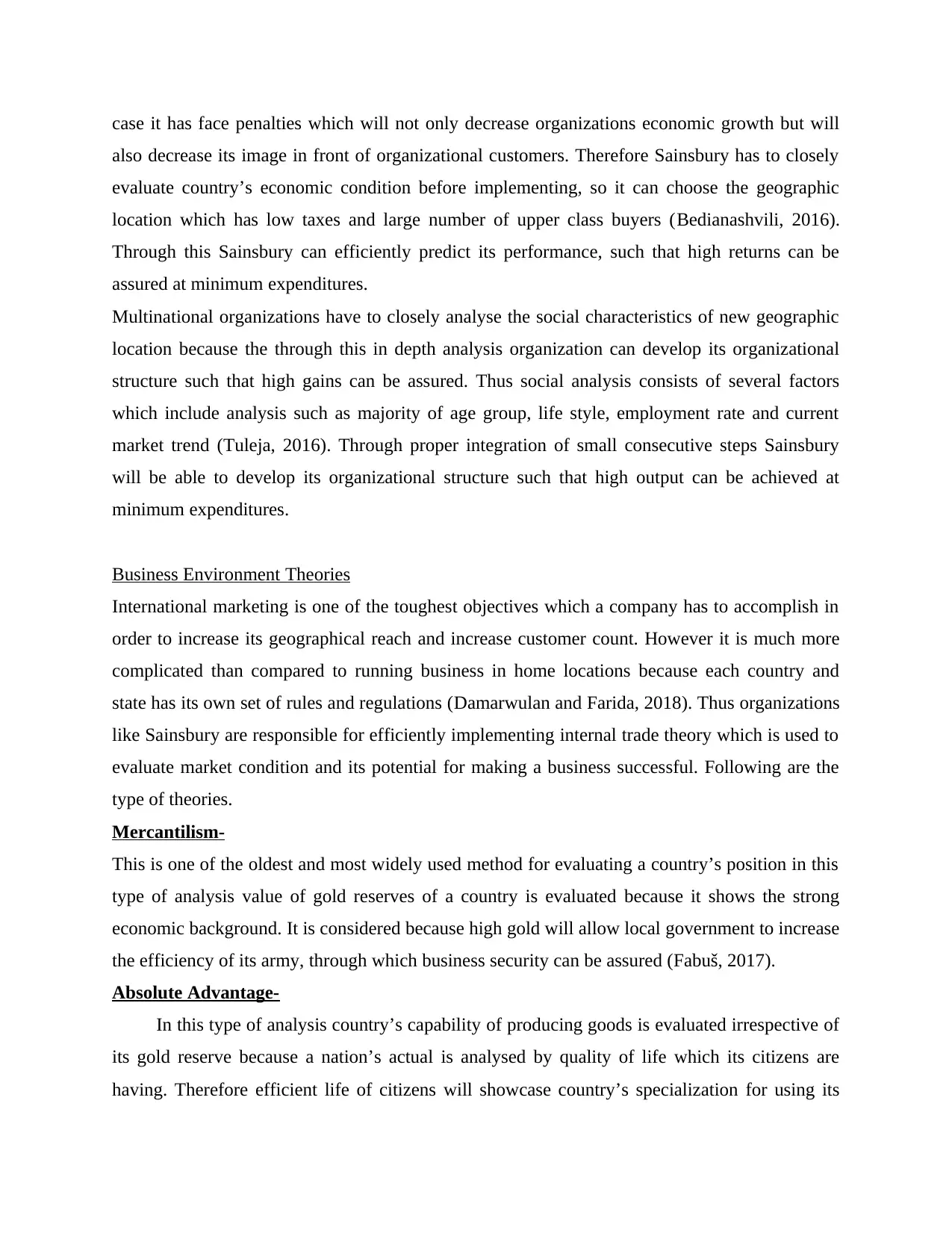
case it has face penalties which will not only decrease organizations economic growth but will
also decrease its image in front of organizational customers. Therefore Sainsbury has to closely
evaluate country’s economic condition before implementing, so it can choose the geographic
location which has low taxes and large number of upper class buyers (Bedianashvili, 2016).
Through this Sainsbury can efficiently predict its performance, such that high returns can be
assured at minimum expenditures.
Multinational organizations have to closely analyse the social characteristics of new geographic
location because the through this in depth analysis organization can develop its organizational
structure such that high gains can be assured. Thus social analysis consists of several factors
which include analysis such as majority of age group, life style, employment rate and current
market trend (Tuleja, 2016). Through proper integration of small consecutive steps Sainsbury
will be able to develop its organizational structure such that high output can be achieved at
minimum expenditures.
Business Environment Theories
International marketing is one of the toughest objectives which a company has to accomplish in
order to increase its geographical reach and increase customer count. However it is much more
complicated than compared to running business in home locations because each country and
state has its own set of rules and regulations (Damarwulan and Farida, 2018). Thus organizations
like Sainsbury are responsible for efficiently implementing internal trade theory which is used to
evaluate market condition and its potential for making a business successful. Following are the
type of theories.
Mercantilism-
This is one of the oldest and most widely used method for evaluating a country’s position in this
type of analysis value of gold reserves of a country is evaluated because it shows the strong
economic background. It is considered because high gold will allow local government to increase
the efficiency of its army, through which business security can be assured (Fabuš, 2017).
Absolute Advantage-
In this type of analysis country’s capability of producing goods is evaluated irrespective of
its gold reserve because a nation’s actual is analysed by quality of life which its citizens are
having. Therefore efficient life of citizens will showcase country’s specialization for using its
also decrease its image in front of organizational customers. Therefore Sainsbury has to closely
evaluate country’s economic condition before implementing, so it can choose the geographic
location which has low taxes and large number of upper class buyers (Bedianashvili, 2016).
Through this Sainsbury can efficiently predict its performance, such that high returns can be
assured at minimum expenditures.
Multinational organizations have to closely analyse the social characteristics of new geographic
location because the through this in depth analysis organization can develop its organizational
structure such that high gains can be assured. Thus social analysis consists of several factors
which include analysis such as majority of age group, life style, employment rate and current
market trend (Tuleja, 2016). Through proper integration of small consecutive steps Sainsbury
will be able to develop its organizational structure such that high output can be achieved at
minimum expenditures.
Business Environment Theories
International marketing is one of the toughest objectives which a company has to accomplish in
order to increase its geographical reach and increase customer count. However it is much more
complicated than compared to running business in home locations because each country and
state has its own set of rules and regulations (Damarwulan and Farida, 2018). Thus organizations
like Sainsbury are responsible for efficiently implementing internal trade theory which is used to
evaluate market condition and its potential for making a business successful. Following are the
type of theories.
Mercantilism-
This is one of the oldest and most widely used method for evaluating a country’s position in this
type of analysis value of gold reserves of a country is evaluated because it shows the strong
economic background. It is considered because high gold will allow local government to increase
the efficiency of its army, through which business security can be assured (Fabuš, 2017).
Absolute Advantage-
In this type of analysis country’s capability of producing goods is evaluated irrespective of
its gold reserve because a nation’s actual is analysed by quality of life which its citizens are
having. Therefore efficient life of citizens will showcase country’s specialization for using its
Paraphrase This Document
Need a fresh take? Get an instant paraphrase of this document with our AI Paraphraser
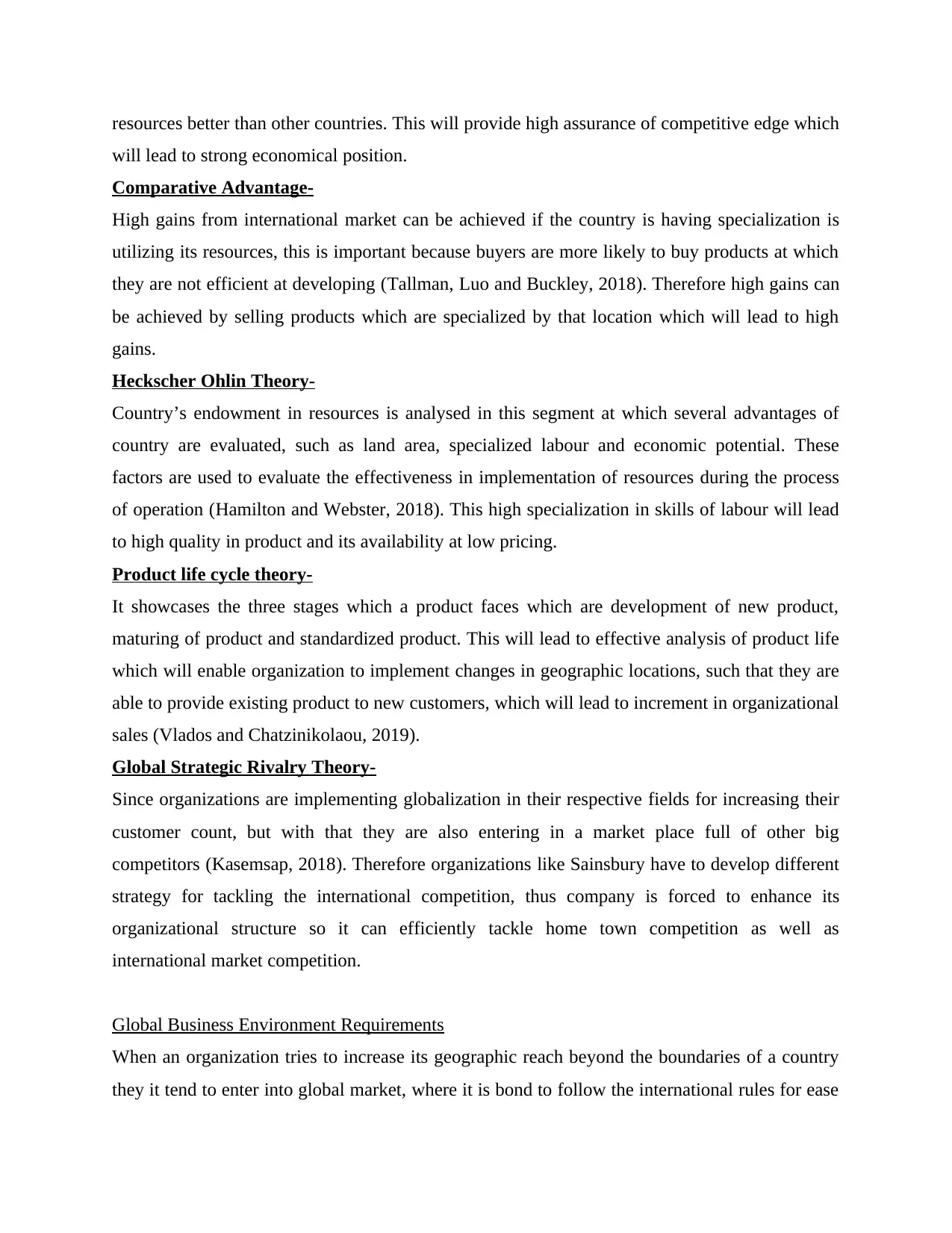
resources better than other countries. This will provide high assurance of competitive edge which
will lead to strong economical position.
Comparative Advantage-
High gains from international market can be achieved if the country is having specialization is
utilizing its resources, this is important because buyers are more likely to buy products at which
they are not efficient at developing (Tallman, Luo and Buckley, 2018). Therefore high gains can
be achieved by selling products which are specialized by that location which will lead to high
gains.
Heckscher Ohlin Theory-
Country’s endowment in resources is analysed in this segment at which several advantages of
country are evaluated, such as land area, specialized labour and economic potential. These
factors are used to evaluate the effectiveness in implementation of resources during the process
of operation (Hamilton and Webster, 2018). This high specialization in skills of labour will lead
to high quality in product and its availability at low pricing.
Product life cycle theory-
It showcases the three stages which a product faces which are development of new product,
maturing of product and standardized product. This will lead to effective analysis of product life
which will enable organization to implement changes in geographic locations, such that they are
able to provide existing product to new customers, which will lead to increment in organizational
sales (Vlados and Chatzinikolaou, 2019).
Global Strategic Rivalry Theory-
Since organizations are implementing globalization in their respective fields for increasing their
customer count, but with that they are also entering in a market place full of other big
competitors (Kasemsap, 2018). Therefore organizations like Sainsbury have to develop different
strategy for tackling the international competition, thus company is forced to enhance its
organizational structure so it can efficiently tackle home town competition as well as
international market competition.
Global Business Environment Requirements
When an organization tries to increase its geographic reach beyond the boundaries of a country
they it tend to enter into global market, where it is bond to follow the international rules for ease
will lead to strong economical position.
Comparative Advantage-
High gains from international market can be achieved if the country is having specialization is
utilizing its resources, this is important because buyers are more likely to buy products at which
they are not efficient at developing (Tallman, Luo and Buckley, 2018). Therefore high gains can
be achieved by selling products which are specialized by that location which will lead to high
gains.
Heckscher Ohlin Theory-
Country’s endowment in resources is analysed in this segment at which several advantages of
country are evaluated, such as land area, specialized labour and economic potential. These
factors are used to evaluate the effectiveness in implementation of resources during the process
of operation (Hamilton and Webster, 2018). This high specialization in skills of labour will lead
to high quality in product and its availability at low pricing.
Product life cycle theory-
It showcases the three stages which a product faces which are development of new product,
maturing of product and standardized product. This will lead to effective analysis of product life
which will enable organization to implement changes in geographic locations, such that they are
able to provide existing product to new customers, which will lead to increment in organizational
sales (Vlados and Chatzinikolaou, 2019).
Global Strategic Rivalry Theory-
Since organizations are implementing globalization in their respective fields for increasing their
customer count, but with that they are also entering in a market place full of other big
competitors (Kasemsap, 2018). Therefore organizations like Sainsbury have to develop different
strategy for tackling the international competition, thus company is forced to enhance its
organizational structure so it can efficiently tackle home town competition as well as
international market competition.
Global Business Environment Requirements
When an organization tries to increase its geographic reach beyond the boundaries of a country
they it tend to enter into global market, where it is bond to follow the international rules for ease

in doing business. These international rules are made to increase the efficiency in doing easy of
business, this important because each country has its own unique rules and regulations and
organizations like Sainsbury have to follow them. Since business reach is reaching different
market environment therefore importance of detailed market environment evaluation increases
(Lee, 2017). This evaluation consist of analysis of internal and external environment in which
external factor consist of evaluation of micro and macro environment, these factors provides an
ability to identify the threats and opportunities which can be used by organization to develop
effective marketing strategy. The internal factors consist of internal strengths and weaknesses of
organization, which have to be considered by Sainsbury for effectively increasing the
effectiveness of developed working strategy. Study of market environment will empower an
ability for developing effective marketing strategy but with that organization also have to
consider customer requirement because they are the main reason for increasing the geographic
reach (Veselovsky and et.al, 2017). Thus organizational activities must be stay in focus such that
new innovative products can be made available to customers, by which organization will be able
to increase the rarity of product. This will enable organization to implement premium pricing by
which high profit can be achieved which will lead to efficient goals achievement for
organization.
Thus it is important for organizations that they keep improving their organizational
activities such that high returns can be achieved in which improvisation can be done through
improving geographic reach and innovating new products and services. So company will be able
to attract new customers and at the same time maintain the loyalty of existing customers.
Theoretical implementation will allow an ability to develop effective strategy and with
continuous evaluation of current operation Sainsbury can evaluate their performance. Such that it
is able to fulfil every governmental criteria so it doesn’t have to pay penalties and at the same
time provide new products to organizational customer (Aithal, 2017). Through this proper
balancing performance Sainsbury can improve its regulation in front of organizational loyal
customer which will lead to high organizational sales and efficient goal achievement.
CONCLUSION
From the above analysis it can be concluded that due to increasing marketing competition
and ease of achieving organizational goals, organizations such as Sainsbury has to increase their
business, this important because each country has its own unique rules and regulations and
organizations like Sainsbury have to follow them. Since business reach is reaching different
market environment therefore importance of detailed market environment evaluation increases
(Lee, 2017). This evaluation consist of analysis of internal and external environment in which
external factor consist of evaluation of micro and macro environment, these factors provides an
ability to identify the threats and opportunities which can be used by organization to develop
effective marketing strategy. The internal factors consist of internal strengths and weaknesses of
organization, which have to be considered by Sainsbury for effectively increasing the
effectiveness of developed working strategy. Study of market environment will empower an
ability for developing effective marketing strategy but with that organization also have to
consider customer requirement because they are the main reason for increasing the geographic
reach (Veselovsky and et.al, 2017). Thus organizational activities must be stay in focus such that
new innovative products can be made available to customers, by which organization will be able
to increase the rarity of product. This will enable organization to implement premium pricing by
which high profit can be achieved which will lead to efficient goals achievement for
organization.
Thus it is important for organizations that they keep improving their organizational
activities such that high returns can be achieved in which improvisation can be done through
improving geographic reach and innovating new products and services. So company will be able
to attract new customers and at the same time maintain the loyalty of existing customers.
Theoretical implementation will allow an ability to develop effective strategy and with
continuous evaluation of current operation Sainsbury can evaluate their performance. Such that it
is able to fulfil every governmental criteria so it doesn’t have to pay penalties and at the same
time provide new products to organizational customer (Aithal, 2017). Through this proper
balancing performance Sainsbury can improve its regulation in front of organizational loyal
customer which will lead to high organizational sales and efficient goal achievement.
CONCLUSION
From the above analysis it can be concluded that due to increasing marketing competition
and ease of achieving organizational goals, organizations such as Sainsbury has to increase their
⊘ This is a preview!⊘
Do you want full access?
Subscribe today to unlock all pages.

Trusted by 1+ million students worldwide
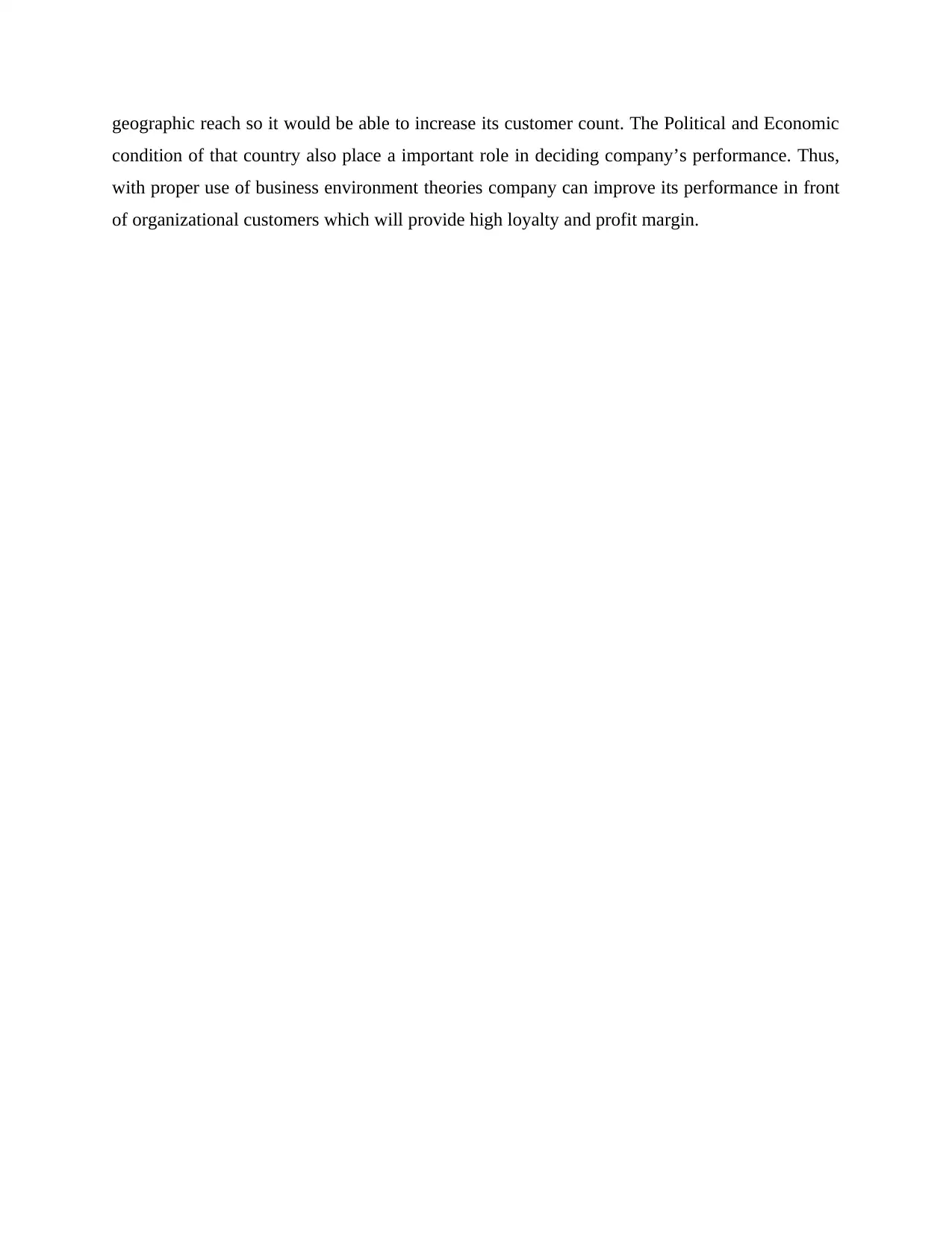
geographic reach so it would be able to increase its customer count. The Political and Economic
condition of that country also place a important role in deciding company’s performance. Thus,
with proper use of business environment theories company can improve its performance in front
of organizational customers which will provide high loyalty and profit margin.
condition of that country also place a important role in deciding company’s performance. Thus,
with proper use of business environment theories company can improve its performance in front
of organizational customers which will provide high loyalty and profit margin.
Paraphrase This Document
Need a fresh take? Get an instant paraphrase of this document with our AI Paraphraser
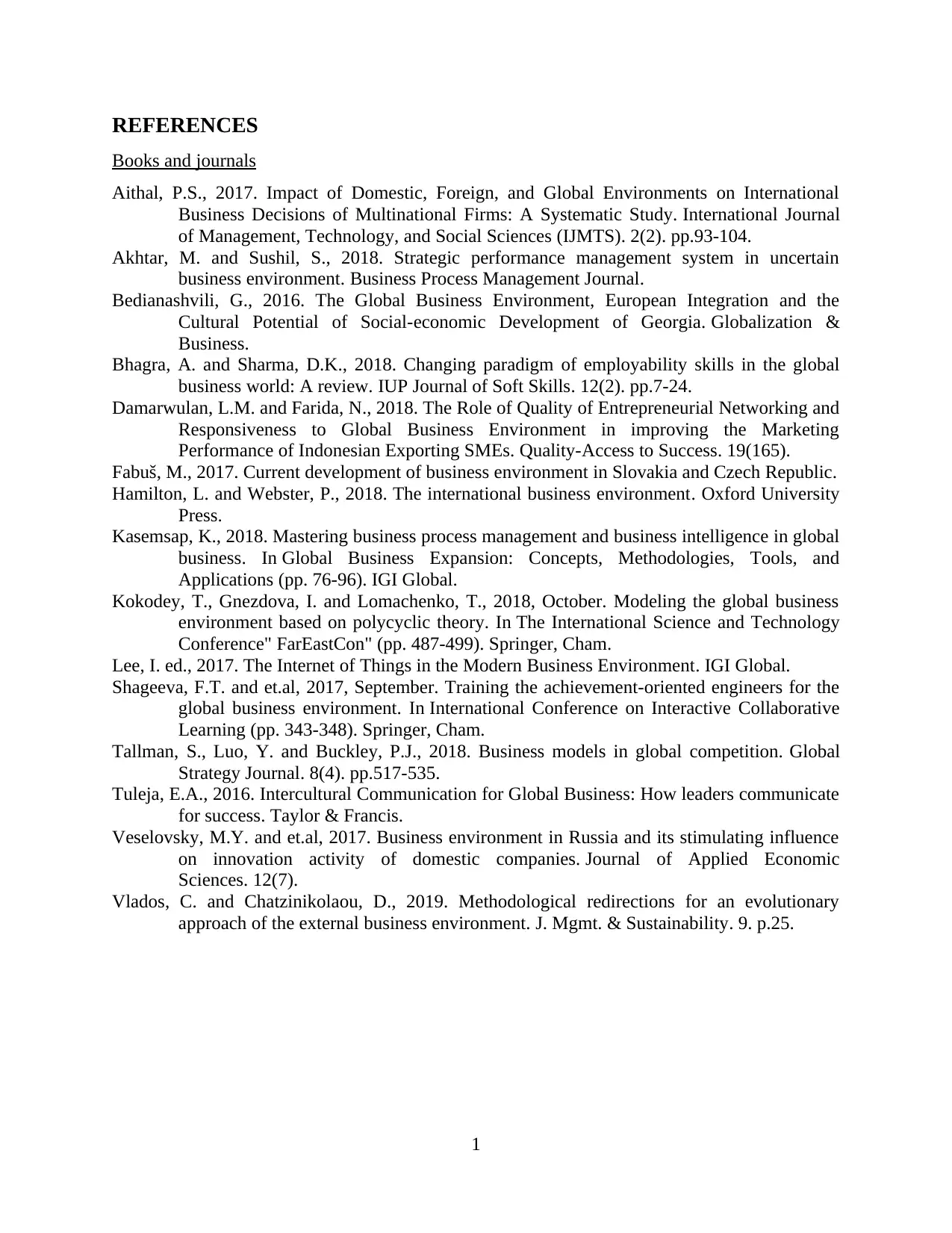
REFERENCES
Books and journals
Aithal, P.S., 2017. Impact of Domestic, Foreign, and Global Environments on International
Business Decisions of Multinational Firms: A Systematic Study. International Journal
of Management, Technology, and Social Sciences (IJMTS). 2(2). pp.93-104.
Akhtar, M. and Sushil, S., 2018. Strategic performance management system in uncertain
business environment. Business Process Management Journal.
Bedianashvili, G., 2016. The Global Business Environment, European Integration and the
Cultural Potential of Social-economic Development of Georgia. Globalization &
Business.
Bhagra, A. and Sharma, D.K., 2018. Changing paradigm of employability skills in the global
business world: A review. IUP Journal of Soft Skills. 12(2). pp.7-24.
Damarwulan, L.M. and Farida, N., 2018. The Role of Quality of Entrepreneurial Networking and
Responsiveness to Global Business Environment in improving the Marketing
Performance of Indonesian Exporting SMEs. Quality-Access to Success. 19(165).
Fabuš, M., 2017. Current development of business environment in Slovakia and Czech Republic.
Hamilton, L. and Webster, P., 2018. The international business environment. Oxford University
Press.
Kasemsap, K., 2018. Mastering business process management and business intelligence in global
business. In Global Business Expansion: Concepts, Methodologies, Tools, and
Applications (pp. 76-96). IGI Global.
Kokodey, T., Gnezdova, I. and Lomachenko, T., 2018, October. Modeling the global business
environment based on polycyclic theory. In The International Science and Technology
Conference" FarEastСon" (pp. 487-499). Springer, Cham.
Lee, I. ed., 2017. The Internet of Things in the Modern Business Environment. IGI Global.
Shageeva, F.T. and et.al, 2017, September. Training the achievement-oriented engineers for the
global business environment. In International Conference on Interactive Collaborative
Learning (pp. 343-348). Springer, Cham.
Tallman, S., Luo, Y. and Buckley, P.J., 2018. Business models in global competition. Global
Strategy Journal. 8(4). pp.517-535.
Tuleja, E.A., 2016. Intercultural Communication for Global Business: How leaders communicate
for success. Taylor & Francis.
Veselovsky, M.Y. and et.al, 2017. Business environment in Russia and its stimulating influence
on innovation activity of domestic companies. Journal of Applied Economic
Sciences. 12(7).
Vlados, C. and Chatzinikolaou, D., 2019. Methodological redirections for an evolutionary
approach of the external business environment. J. Mgmt. & Sustainability. 9. p.25.
1
Books and journals
Aithal, P.S., 2017. Impact of Domestic, Foreign, and Global Environments on International
Business Decisions of Multinational Firms: A Systematic Study. International Journal
of Management, Technology, and Social Sciences (IJMTS). 2(2). pp.93-104.
Akhtar, M. and Sushil, S., 2018. Strategic performance management system in uncertain
business environment. Business Process Management Journal.
Bedianashvili, G., 2016. The Global Business Environment, European Integration and the
Cultural Potential of Social-economic Development of Georgia. Globalization &
Business.
Bhagra, A. and Sharma, D.K., 2018. Changing paradigm of employability skills in the global
business world: A review. IUP Journal of Soft Skills. 12(2). pp.7-24.
Damarwulan, L.M. and Farida, N., 2018. The Role of Quality of Entrepreneurial Networking and
Responsiveness to Global Business Environment in improving the Marketing
Performance of Indonesian Exporting SMEs. Quality-Access to Success. 19(165).
Fabuš, M., 2017. Current development of business environment in Slovakia and Czech Republic.
Hamilton, L. and Webster, P., 2018. The international business environment. Oxford University
Press.
Kasemsap, K., 2018. Mastering business process management and business intelligence in global
business. In Global Business Expansion: Concepts, Methodologies, Tools, and
Applications (pp. 76-96). IGI Global.
Kokodey, T., Gnezdova, I. and Lomachenko, T., 2018, October. Modeling the global business
environment based on polycyclic theory. In The International Science and Technology
Conference" FarEastСon" (pp. 487-499). Springer, Cham.
Lee, I. ed., 2017. The Internet of Things in the Modern Business Environment. IGI Global.
Shageeva, F.T. and et.al, 2017, September. Training the achievement-oriented engineers for the
global business environment. In International Conference on Interactive Collaborative
Learning (pp. 343-348). Springer, Cham.
Tallman, S., Luo, Y. and Buckley, P.J., 2018. Business models in global competition. Global
Strategy Journal. 8(4). pp.517-535.
Tuleja, E.A., 2016. Intercultural Communication for Global Business: How leaders communicate
for success. Taylor & Francis.
Veselovsky, M.Y. and et.al, 2017. Business environment in Russia and its stimulating influence
on innovation activity of domestic companies. Journal of Applied Economic
Sciences. 12(7).
Vlados, C. and Chatzinikolaou, D., 2019. Methodological redirections for an evolutionary
approach of the external business environment. J. Mgmt. & Sustainability. 9. p.25.
1

2
⊘ This is a preview!⊘
Do you want full access?
Subscribe today to unlock all pages.

Trusted by 1+ million students worldwide
1 out of 9
Related Documents
Your All-in-One AI-Powered Toolkit for Academic Success.
+13062052269
info@desklib.com
Available 24*7 on WhatsApp / Email
![[object Object]](/_next/static/media/star-bottom.7253800d.svg)
Unlock your academic potential
Copyright © 2020–2025 A2Z Services. All Rights Reserved. Developed and managed by ZUCOL.



